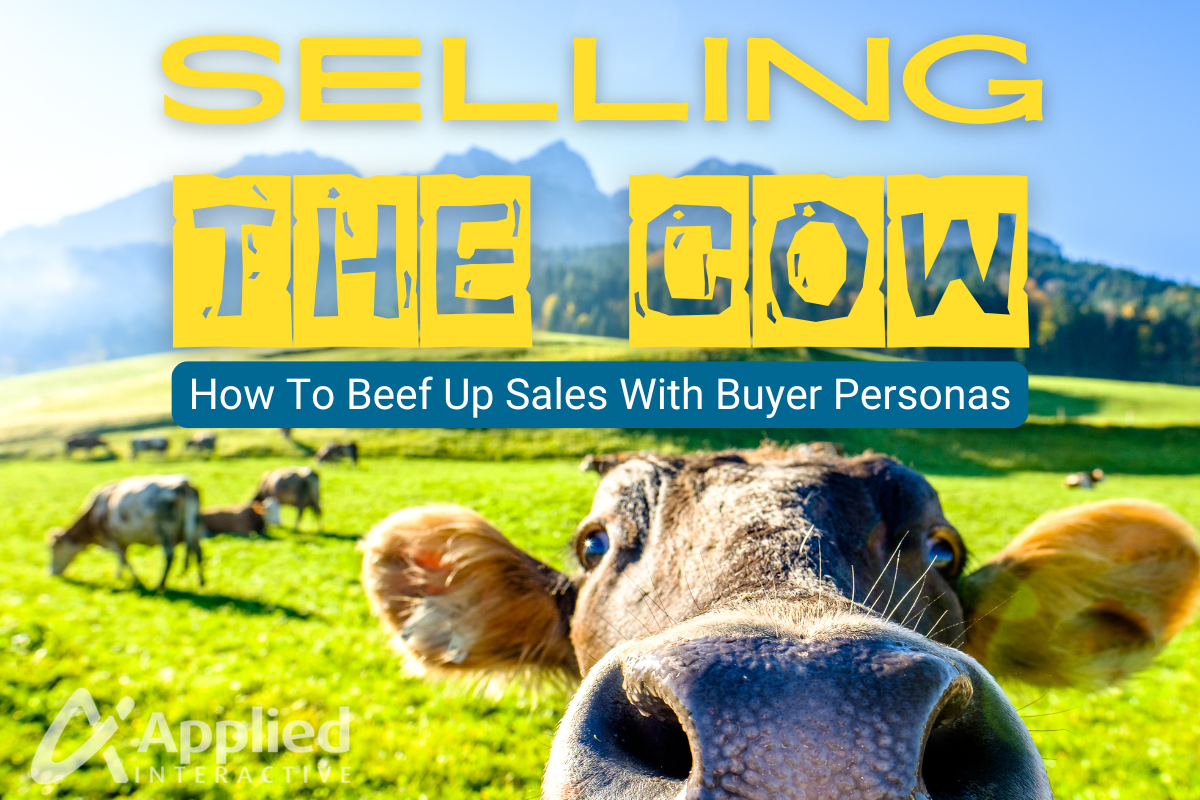
Imagine you’ve been tasked with selling a cow. It seems straightforward enough, right? You craft an initial pitch that’s universally appealing:
- Get fresh, wholesome milk for your family!
- Make delicious burgers and steaks!
- Tan the hide and craft fine leather goods!
It’s a solid start. You’ve highlighted a variety of benefits that appeal to different uses for the cow. Your pitch touches on health and nutrition, culinary enjoyment, and even craft and utility. From your perspective, it’s hard to imagine anyone not seeing the value here.
And it works—somewhat. A third of your audience seems fired up and ready to buy, but that leaves over 60% unenthused. What gives?
You ask a few simple questions about your audience and the problems with your tactics are immediately made clear. A third of your audience is vegan. They wouldn’t dream of using the cow for milk, meat, or leather, and they’re already bristling at your pitch. Another third of your audience is experienced cattle ranchers. They don’t need someone to tell them about the basic uses of a cow—they already have herds of their own and know exactly what they’re looking for.
Suddenly, your one-size-fits-all message isn’t so effective. For the vegans, it’s downright off-putting, and for the ranchers, it’s too generic to add any real value. Your best pitch is now failing to connect with a large portion of your audience—or worse, alienating them from your brand entirely.
You’ve fallen victim to one of the most common pitfalls in sales: you’re focusing on the cow, not the people you’re trying to sell it to. You’ve crafted a pitch that’s all about the product without considering what actually motivates your prospects to buy. Many sellers believe a good product will speak for itself, but the truth is that your audience will only hear what speaks to their needs.
Segmentation and Tailored Messaging
So, you pivot. Recognizing that your audience isn’t one homogenous group, you take a more thoughtful approach. Instead of trying to sell the cow to everyone with the same pitch, you tailor your messaging to resonate with each unique group. You invite the vegans into one room and the cattle ranchers into another, crafting distinct narratives that speak directly to their priorities and values.
To the Ranchers:
You focus on what matters most to them: the opportunity to meet their established business goals.

“This isn’t just any cow,” you say.
“This is premium breeding stock. Daisy has the genetics to produce the healthiest, heartiest calves. Whether you’re increasing the size of your herd, improving the quality of your livestock, or meeting market demands, investing in Daisy isn’t just adding a cow to your farm—it’s a smart decision that ensures continued success in a competitive industry.”
This pitch resonates with the ranchers because it aligns with their strategic operational objectives. By addressing these needs directly, you’ve positioned Daisy not just as an animal but as a valuable asset that helps them achieve measurable results.
To the Vegans:
For this group, the story changes entirely. You shift away from functionality and focus on their values.
“This isn’t just any cow,” you say.
“This is Daisy, a gentle soul who deserves a long, happy life. She spends her days grazing peacefully, and with your help, she can avoid the slaughterhouse and continue to live in safety and comfort.
By purchasing Daisy, you’re making a powerful statement: This isn’t just a transaction—it’s an act of clemency.”
This message is compelling for the vegans because it aligns with their core beliefs and values. You’ve shown that you understand their perspective, reframed Daisy as a cause they can champion, and created an emotional connection to your brand.
The Result
Both groups now see value in the cow—not because the cow has changed, but because you’ve framed her in a way that resonates with what they care about most. Instead of trying to make one pitch fit all use cases, you’ve crafted messaging that meets each audience where they are, tapping into their unique motivations and priorities.
More Sales, Same Cow
Here’s the twist: the cow hasn’t changed. Every aspect of the product remains the same, from physical characteristics to potential uses. What has changed is the way you’ve approached your audience. By taking the time to understand their needs and tailoring your message to appeal to the factors that motivate their decision-making, you’ve transformed what could have been a single sale into multiple, highly targeted sales.
The broad pitch you started with may have caught a flicker of interest, but it lacked the precision to truly resonate with anyone. It cast too wide a net, leaving room for confusion or indifference. The tailored pitches, however, landed exactly as they were intended. They connected on a personal level, speaking directly to what each group cared about most—whether it was achieving business goals or aligning with personal values.
This shift demonstrates a powerful truth: success in sales isn’t just about the quality of the product. It’s about the quality of the connection you make with your audience.
The Lesson for Manufacturers
This simple parable carries a vital lesson for manufacturers: understanding your audience is the foundation of effective sales and communication. Whether you’re selling precision parts, industrial machinery, or raw materials, your ability to make a meaningful connection with your customers depends on understanding what drives them.
It’s not enough to highlight what your product can do. You need to think about how it fits into the lives and businesses of the people you’re selling to. Every customer group has its own priorities, challenges, and goals, and those factors shape how they perceive the value of what you’re offering.
One of the best tools manufacturers have to achieve this is Buyer Personas. A buyer persona is a research-based profile of your ideal customer, based on interviews, surveys, and feedback from actual customers. By speaking directly to the people who use or buy your product, you gain valuable insights into their motivations, frustrations, and decision-making processes to create a detailed avatar that represents the typical customer within a segment. This persona serves as a guide for all your messaging and marketing content, ensuring it resonates with the right audience. Instead of guessing what your customers want to hear or blasting the same tired talking points to every prospect, you’ll have a well-defined blueprint for crafting messaging that aligns with their priorities and goals.
Want to learn how to create effective Buyer Personas?
 Align your messaging with your customers’ needs. Download our DIY B2B Buyer Persona Kit and start building high-impact profiles today.
Align your messaging with your customers’ needs. Download our DIY B2B Buyer Persona Kit and start building high-impact profiles today.
For example, a buyer persona might reveal that a segment of your audience is particularly concerned with reducing downtime in production lines. With this information, you can highlight how your product’s durability and ease of maintenance address that exact concern. Similarly, another persona might emphasize the importance of regulatory compliance, allowing you to craft messaging that focuses on certifications and safety standards.
When you invest the time and resources in well-researched buyer personas, you’re not just improving your sales pitch—you’re ensuring that your marketing, communication, and customer interactions are all optimized to build trust and form lasting customer relationships.
Final Thoughts
Whether you’re selling precision parts, industrial machinery, or raw materials, understanding your audience is the foundation for communicating your value to the right people in a compelling way.
The story of selling the cow illustrates the importance of tailoring your messaging to resonate with your audience’s unique needs and motivations. When manufacturers take the time to understand their customers, the results are clear: stronger relationships, more effective communication, and, ultimately, greater success in the marketplace.
Partner with Applied Interactive to Connect with Your Audience
Your products and services are exceptional—now it’s time to ensure your messaging reflects that. At Applied Interactive, we specialize in helping manufacturers like you understand your customers and create targeted messaging that resonates. Whether you need help developing buyer personas, crafting compelling content, or building a marketing strategy that drives results, we’re here to make it happen.
Let’s work together to communicate your value, strengthen customer relationships, and achieve your business goals.